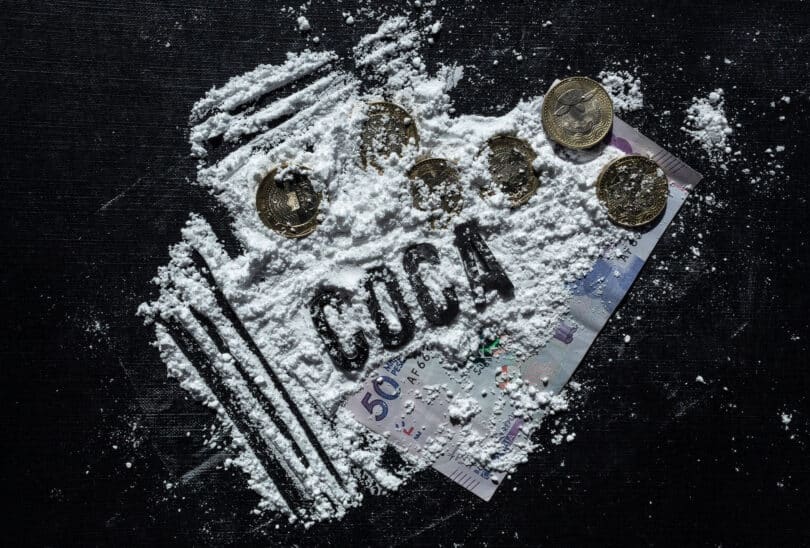Colombia is already the place most associated with cocaine. A recent report now indicates that the country possibly exports more cocaine than oil.
Does Colombia export more cocaine than oil?
The first reality of a headline like this, is that there are never going to be hard numbers. Oil is an official product of export, cocaine is not. Much like any illegal good; all estimates for export come from arrests and seizures, as well as informant information. Nothing official. This is then used to draw wider estimates for the entire market. So whereas we have a huge amount of official data on the oil industry; the information for the cocaine industry is less defined. The indication right now, is that more has been found and seized; both of cocaine, and the actual coca plant.
A recent Bloomberg article goes into this topic, and claims that cocaine is about to outdo oil in terms of exported products from Colombia. Bloomberg’s report comes not long after the UN’s Office On Drugs And Crime (UNODC) announced that cocaine production in Colombia has been at a record high for four years. This is speculation, and technically translates to what was recovered in seizures, or destroyed. So it could be hype, as there is no confirmation; or, its possible the UN underestimates the market.
The UN report credits Colombia as the largest coca cultivator. Coca is the regular plant that’s used to make cocaine. A plant which is generally illegal, even though its effects are just mild stimulation; not that different from caffeine. This tends to happen. Governments don’t want illicit drug trades, and demonize any plant used for synthesis. Think about sassafras. That plant has 0 psychoactive properties, and tons of medical benefits; yet its illegal. Of course, nothing backs up a danger; but it is used to synthesize MDMA.

How much coca is grown in the country of just over 50 million inhabitants? According to the UN, the number of acres increased to 504,000 in 2022; making for a 13% year over year increase. In 2018 it was said to be 418,00 acres. The UN says this is enough to grow 1.4 million metric tons of coca, which can be turned into 1,738 metric tons of cocaine hydrochloride. This is supposedly a 24% increase from 2021.
In terms of oil, as of December 2022, ceicdata.com reports the country exports 487 barrels a day, up from 422 a day, the year before. The Bloomberg writer points to a small dip earlier this year, claiming a 30% decline; which is out of sync with the increased rate of production. The Bloomberg article didn’t speak of the horrific damage of oil drilling, and the related deaths from this. The writer was only concerned about a comparison to the growing of a plant. I wouldn’t mention this as an issue (as oil damage wasn’t the point), if the article didn’t come off as a ploy to raise fear over cocaine, to Colombia’s detriment.
Why do I say this? Because the meat of the article is in comparing revenue between cocaine and oil. The writer says the cocaine industry brought in $18.2 billion in 2022, compared to oil’s $19.1 billion. But the cocaine number isn’t real. Governments, journalists, and bodies like the UN, love to put out numbers; but they don’t like to explain that they’re making them up. It’s a raw estimate, with no hard figures to back it up; same for any black market. Which means any story based on a direct comparison like this, is nearly baseless. Estimates can be useful, but they have limits.
A tale of two Colombias
One of the things that makes Colombia interesting, is its large and growing travel industry. The low value of the Colombian peso makes it an optimal location for low-budget travelers; and its currently one of the few places in the world you can still get a cheap hostel bed. Like old school cheap, the equivalent of just a few bucks. This is a massive benefit for those looking to travel in affordable places.
At the same time, its also a growing expat hub. This refers to people who leave a country, but generally stay put for longer amounts of time where they go, or actually relocate altogether to a specific location. This opens the door to higher paid remote workers, which is different from a standard broke traveler crowd. Colombia is now a favored destination for people who don’t have to go into an office; particularly if they do have to submit to specific US time zones.
How many tourists are coming through the country? According to a July article from tourism-review, the country experienced a 10.4% increase when comparing May 2022 and May 2023. May 2023 had 375,409 visitors, while the previous May had 340,060. The current number is 15% increased from 2019, when 326,344 visited the country.

In the first part of the year, January – May, approximately 2,249,411 visited the country, up 20% from the same time period of four years before. The number is a 36.7% increase from 2022; however corona did slow things down, so the dip makes sense. These numbers are still way lower than Mexico, for example, which according to Statista had 38 million international tourists enter the country in 2022. But it does show a growing trend for tourism in general.
It’s almost hard to believe that this level of travel goes on in either Colombia or Mexico; they’re both rather dangerous countries. I can attest to the quietness on the streets after dark in most parts of Mexico, save for a few very-high tourist locations. It’s hard to imagine a place being more naturally locked down. Even in the majority of tourist areas, people are told not to walk alone at night. Yet travelers keep flocking over despite this; drawn largely by the lower-valued currencies, which create useful exchange rates.
According to Statista, Mexico’s homicide rate in 2022, was 25.2 out of 100,000. That means 25.2 people out of every 100,000, get murdered. As a comparison to this, the US had a rate of about 6.81 per 100,000 in 2022. Countries like France or the UK, are closer to 1 per 100,000. Where does Colombia stand? Colombia topped Mexico in 2022, with 26.1. It’s not exactly a safe country; but like Mexico, it shows a growing tourism rate despite the intense murder rate. And this growing tourism might give the country another major option for income.
This burgeoning travel industry presents an alternate revenue stream for a country that desperately needs it. When reading a fear article about coca, its easy to forget how many people live off the industry; and that taking it away, means taking away income. Attempting to wipe it out without an alternate source of income, is unlikely to improve issues of violence. It would plunge that much more of the country into poverty. Although having said that, it also simply won’t work; something we can know from looking at history. Drug wars over plants mean intense damage; for what is an unnecessary, and unattainable, goal.
Should we worry that Colombia exported more cocaine?
Colombia is one of many countries that suffers the residual fallout from years of colonization by European settlers. Weirdly enough, when stronger foreign powers essentially enslave a people in their own country, it tends to build resentment. This resentment is often funneled into criminal groups, since they represent a form of local power, when people have none. It’s not logically shocking that these then grow into untamable operations.
Bodies like the UN and US love to make it sound like countries like Colombia and Mexico can’t get it together. But they like to leave out the massive subjugation and horrible treatment of the natives of these countries, that went on for hundreds of years; generally culminating in some independence effort. While these reports about Colombia are seemingly used to denigrate new president Gustavo Petro, and drive fear about cocaine production; the uglier reality is that this situation was created by European and American interests; with no regard to the local populations.

A comparison to oil is meant to draw ‘ahhs,’ but it doesn’t have any value. A couple years ago, Colombia floated the idea of legalizing coca, and the government buying out the industry. Why? Because it would lower the cost compared to rooting out crops and production. That’s how much is spent trying to get rid of a plant in a poverty-ridden, third world country…talk about a waste of money. The government would have sold it out medically; because it is legal in so many places. America emphatically doesn’t want this, which helps promote articles like what came out in Bloomberg.
If a legal industry sounds impossible, consider that Bolivia and Peru are both coca legal. And yet they’re not spoken about like Colombia in terms of cartel violence or trafficking. Both kill the argument that a coca trade has to be violent, both with a murder rate well under 4 out of 100,000… that’s lower than America!! Colombia hasn’t legalized yet, likely for fear of US retaliation; and maybe an understanding that this could increase violence if the government tried to take over a narco operation. Bolivia and Peru indicate the violence in Colombia might be systemic, though, and not related to a specific trade.
In the end, like it or not, there’s no getting rid of it. Plant drugs don’t go away, because anyone can make them. It’s a reality. The sooner it gets accepted, the less people that have to die trying to do something that can’t (and doesn’t need) to be done. Beyond the fact coca is not dangerous, cocaine has been a part of life for a long time, and we’re used to it. It doesn’t for a second cause the kind of insane overdose and death situation as drugs like synthetic opioids. Yet somehow, we don’t hear fear-mongering news stories of the latest pharmaceutical sales overseas. We hear about poor farmers growing a medicinal plant.
Should we worry about cocaine; or that journalists with no direct numbers, are telling us Colombia produced similar amounts of cocaine and oil? No. Maybe we should worry about the fact that it takes over 4,000 Colombian pesos to equal $1 USD, though. That is a point of major concern; because it speaks to the quality of life of millions of people.
Maybe we should worry about the incredible poverty of the country, and the implicit disease and overall suffering related to poverty. Maybe we should worry about what happens to a country like this when a main industry is wiped out, or when there is a major attempt to take it out. Maybe, just maybe, we could actually worry about the health and well being of the residents; rather than acting like trying to take away one of the biggest revenue lines (which is coca, NOT cocaine), won’t cause even more harm.
Conclusion
Colombia might export more cocaine than oil; and maybe not. And maybe it doesn’t matter. Cocaine isn’t scarier than it used to be. Perhaps, rather than trying to take out a regular farming industry; those worried about violence should consider investing in systems that promote a higher quality of life for residents. Doesn’t that sound better than trying to wipe out the income stream of a country where over 10% of people live off less than $1.15 a day, and over 38% live on no more than $3.85?
Welcome readers! We appreciate you joining us at Cannadelics.com; a premiere website for independent coverage of the drugs world at large. We’ll keep you up-to-date with everything going on; so come around frequently. And sign up to our Cannadelics Weekly Newsletter; so you’re always aware of the top news stories.









